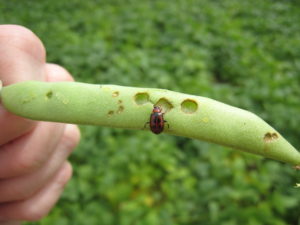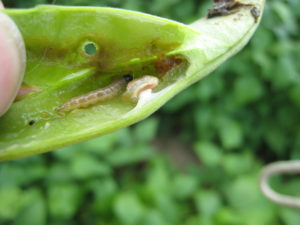It’s time to get out and scout for WBC damage in dry beans. Based on trap counts we are now confident that some counties experienced peak flight the last week of July and others the first week of August. Though I will admit that some trap sites are still catching lots of moths, especially the bean trap sites. And the storm fronts that have pushed across the province over the last week have also been delivering some moths from Michigan. One of our Grand Bend traps caught over 400 moths early this week, thanks to the same storm system that also hit Goderich.
In dry beans, scouting 10 to 21 days after peak flight is the ideal time to determine if control is necessary. Scout a field for 15 to 30 mins. Select random plants in the field and take a good look at all of the pods on the plant. If you can easily find pods with holes in them during that time, you need to spray. If there is just surface feeding or scars on the pod, it may not be WBC damage. It could be from bean leaf beetles. The only way to know for sure if it is western bean cutworm damage is if there are holes mining directly into the cavity of the pod. Seed inside will also be fed on. Open up the pod and see if anything is in there. If you find a larvae, it is most likely European corn borer. If nothing is in the pod, it is probably safe to blame the damage on WBC. WBC larvae only feed at night in dry beans. They drop out of the pods before sunrise and hang out in the soil or under crop debris during the day. If in the time that you scout you are only finding a couple of pods with holes, it is not enough damage to warrant a spray. But check again in another week to see if things have changed. Matador and Coragen are both registered for dry beans. Matador has a preharvest interval of 21 days. Coragen has a preharvest interval of 1 day.


